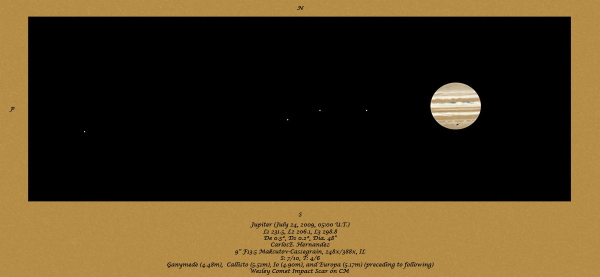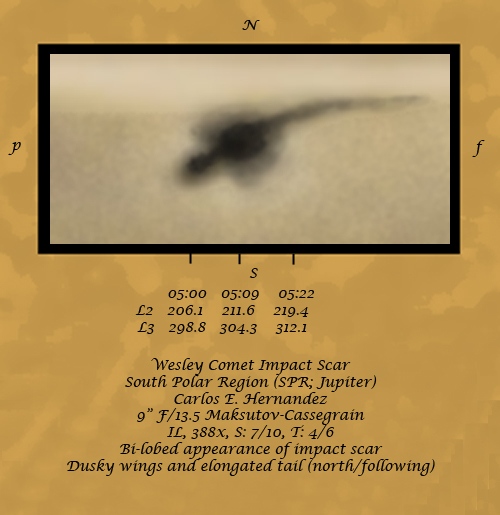
Jupiter and the Wesley Comet Impact Scar
Sketch and Details by Carlos E. Hernandez
I made an observation of Jupiter showing the Wesley Comet Impact Scar (WCIS) over the South Polar Region (SPR) of Jupiter. The impact scar appeared bi-lobed with extensions and a tail.
Date (U.T.): July 24, 2009
Time (U.T.): 05:00
L1 231.5, L2 206.1, L3 298.8
Ds 0.5, De 0.2, Diameter 48″ (Equatorial)
Instrument: 9-inch (23-cm) F/13.5 Maksutov-Cassegrain
Magnification: 248x and 388x
Filters: None
Seeing (1-10): 7, Antoniadi (I-V): II
Transparency (1-6): 4
Notes:
North Polar Region (NPR): Appears dark to dusky (3-4/10) and mottled. No other detail is visible within.
North Temperate Zone (NTZ): Appears shaded to bright (6-7/10) without any detail visible within it.
North Temperate Belt (NTB): Appears to be divided into two thin, dusky (4/10) components (North and South) with a bright (7/10) middle zone. A dark (3/10) elongated condensation is noted along the northern border of the northern component towards the preceding limb.
North Tropical Zone (NTrZ): Appears bright (7/10) without any detail visible within.
North Equatorial Belt (NEB): Appears dark to shaded (3-4/10) with dark condensations (3/10) and bright rifts (7/10) noted within it. Dark (3/10) barges (rods) are noted along the northern border (NRB-N) and blue festoons along the southern border (NEB-S).
Equatorial Zone (EZ): Appears bright (7/10) with a thin, dull (5/10) band over the middle portion (equator). Very bright (8/10) ovals are noted over it’s northern half along the North Equatorial Belt (NEB).
South Equatorial Belt (SEB): Appears dark to dusky (3-4/10) with the southern component (SEB-S) thicker than the northern component (SEB-N). The South Equatorial Belt Zone (SEBZ) appears a pastel orange color with thin, dull (5/10) columns extending between the northern and southern components.
South Tropical Zone (STrZ): Appears bright (7/10) with a thin, angled dusky (4/10) projection over it’s preceding half extending from the northern border of the South Temperate Belt (STB-N).
South Temperate Belt (STB): Appears dark to dusky (3-4/10) with a thin, shaded (6/10) section (zone?) over it’s southern half which contains four bright (7/10) ovals within it’s southern portion.
South Polar Region (SPR): Appears dark to dusky (3-4/10) and mottled. The Wesley Comet impact Scar (WCIS) noted along the central meridian (CM). The WCIS appears very to extremely dark (8-9/10), bi-lobed (smaller southern component than northern), with dusky to dull (4-5/10) projections (“wings”), and thin, dusky (4/10) projection (“tail”) to the north. The WCIS reminds me of the impact scars produced by Shoemaker-Levy 9 in 1994.
The Galilean satellites visible are (preceding to following) Ganymede (4.48m), Callisto (5.51m), Io (4.90m), and Europa (5.17m).
I made a sectional sketch of the Wesley Impact Scar (WCIS). The impact scar appeared as described above (bi-lobed, projections (“wings and a tail”). The preceding end of the impact scar was timed at 05:00 U.T. (L2 206.1/L3 298.9), center (05:09 U.T., L2 211.6/L3 304.3), and following end (05:22 U.T., L2 219.4/L3 312.1).

Sectional view of Jupiter and the Wesley Comet Impact Scar
Sketch and Details by Carlos E. Hernandez
The best of luck in your own observations/imaging of Jupiter and the Wesley Comet Impact Scar (WCIS).
Digital images produced in Photoshop CS3.
Carlos

Carlos,
Impressive wide view.
Is the contrast of impact crater really so good as in wide field sketch?
Thanks for view! 😀
marek
Carlos,
Beautiful sketches and clear and concise write-up.
We have come to expect no less from you.
Frank 🙂